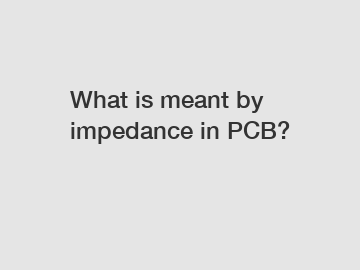What is meant by impedance in PCB?
Impedance in PCB refers to the resistance that an electrical circuit or component presents to the flow of alternating current (AC). It is typically measured in ohms and plays a crucial role in ensuring signal integrity and preventing signal degradation in printed circuit boards (PCBs).
The impedance of a PCB trace is influenced by various factors, such as the width, thickness, and length of the trace, as well as the dielectric constant of the substrate material. When a signal travels along a PCB trace, it encounters impedance mismatches at various points, such as connectors, vias, and other discontinuities. These impedance mismatches can lead to signal reflections, distortions, and even signal loss, affecting the overall performance of the PCB.
To understand the concept of impedance in PCB, it is important to consider the behavior of AC signals in electronic circuits. Unlike DC signals, which flow steadily in one direction, AC signals periodically change their direction and amplitude. The flow of AC current in a circuit generates both resistive and reactive components, which together constitute impedance.

The resistive component of impedance is the actual resistance encountered by the AC current, while the reactive component represents the changing nature of the current due to inductance and capacitance. The interaction between these components gives rise to the impedance of the circuit.
In high-speed digital circuits, such as those found in modern electronics, impedance control is crucial for maintaining signal integrity. At high frequencies, the physical dimensions of traces and components become significant compared to the wavelength of the AC signal. This means that impedance mismatches and reflections can have a significant impact on signal quality.
By designing PCBs with controlled impedance, signal reflections and distortions can be minimized, allowing for reliable transmission of high-speed signals. Impedance control is particularly critical for high-frequency applications, such as RF and microwave circuits, where even slight variations in impedance can result in signal degradation or loss.
The significance of impedance in PCB design extends beyond signal integrity. It also affects power distribution and electromagnetic compatibility (EMC). Properly controlled impedance helps to minimize power losses, voltage drops, and noise coupling in the PCB. This, in turn, improves the overall efficiency and performance of the electronic device.
In conclusion, impedance in PCB refers to the resistance that a circuit or component presents to the flow of AC current. Its understanding and control are crucial for maintaining signal integrity, reducing reflections, and minimizing power losses. By carefully designing traces and components with controlled impedance, PCB designers can ensure the reliable transmission of high-speed signals, improve power distribution, and enhance the overall performance of electronic devices.
The company is the world’s best Lead Free HASL PCB , security product pcb board , security product pcb board supplier. We are your one-stop shop for all needs. Our staff are highly-specialized and will help you find the product you need.

Comments
0